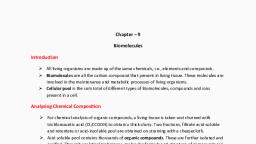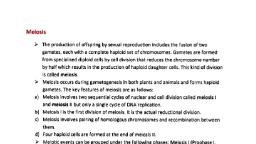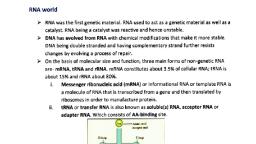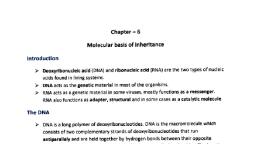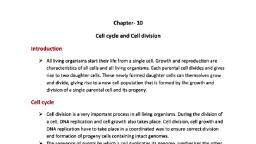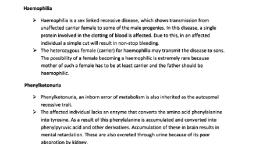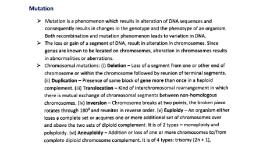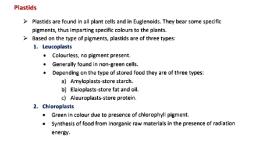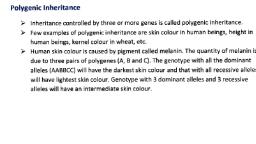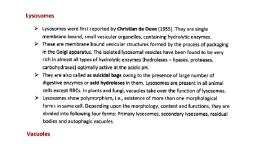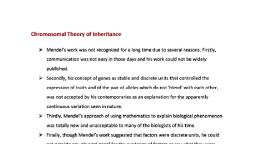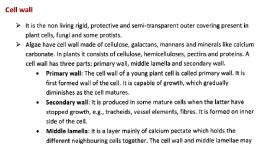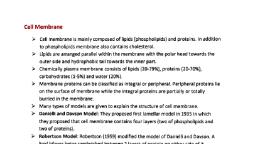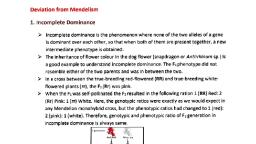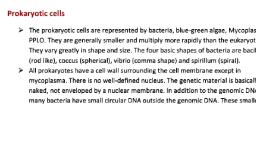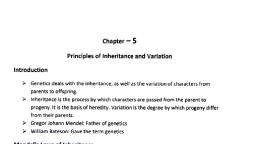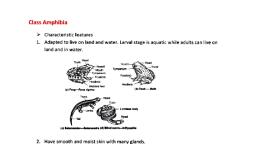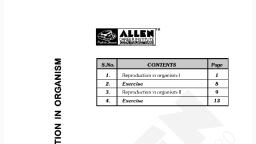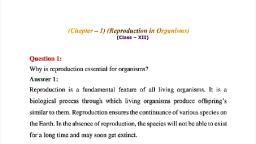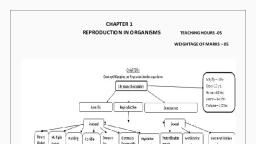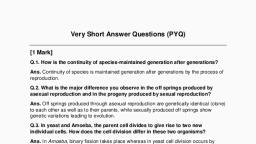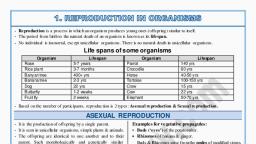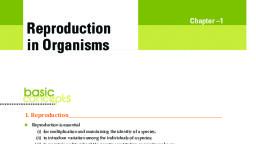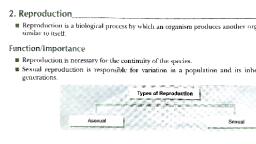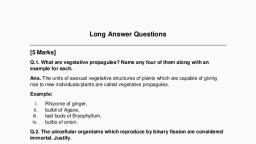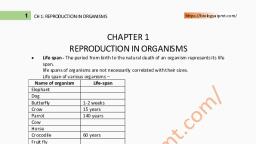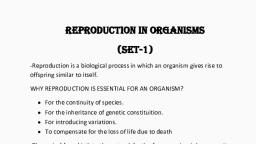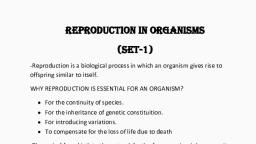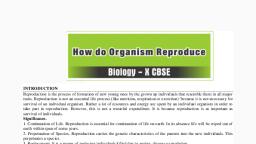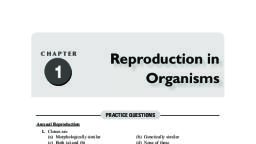Page 1 :
Chapter -1, Reproduction in Organisms, Introduction, ➢ Each and every organism live only for a certain period of time. The period from birth, to natural death of an organism represents its life span., ➢ Life span of an organism usually includes four stages(i) Juvenility: During this stage organism develops the capacity to reproduce., (ii) Maturity: Reproduction begins during this stage., (iii) Ageing and senescence: Ageing is progressive deterioration in the body of the, organisms. The terminal irreversible stage of ageing is called senescence., (iv) Death: Senescence finally leads to death., ➢ Reproduction is defined as a biological process in which an organism gives rise to, young ones similar to itself. The offspring grow, mature and in turn produce new, offspring. Reproduction enables the continuity of the species, generation after, generation., ➢ The reproduction methods are broadly categorized into 2 types namely- asexual, reproduction and sexual reproduction., , Asexual Reproduction, ➢ In asexual reproduction, a single parent is involved in producing offspring, so the, offspring produced are exact copies of their parents. These morphologically and, genetically similar individuals are called clones., ➢ Asexual reproduction is common among single-celled organisms and in plants and, animals with relatively simple organisations., ➢ In protists and monerans, the organism or the parent cell divides into two to give rise, to new individuals. Thus, in these organisms cell division is itself a mode of, reproduction., , Types of Asexual Reproduction, ➢ Fission: It is the division of the parent body into two or more daughter individuals, identical to the parent. It is of 3 types: binary fission e.g., Amoeba, longitudinal e.g.,, Paramecium, multiple fission, e.g. Plasmodium and plasmotomy e.g., Opalina.
Page 2 :
➢ Budding: Daughter individual is formed from a small part or bud, arising from parent, body types, e.g., Yeast, Hydra., , ➢ Gemmae: These are unicellular or multicellular propagules which develop in small, receptacles called gemma cups. They detach from the parent and grow into new, individuals, e.g., Marchantia., ➢ Sporulation: Under unfavourable condition, the Amoeba withdraws its pseudopodia, and secrete a three layered hard covering around itself. This process is known as, encystations. On the arrival of favourable condition, encysted Amoeba divides by, multiple fission and produces many Amoeba or pseudopod to spores. The cyst wall, bursts and these spore liberated in medium to grow up in Amoeba. This, phenomenon is known as Sporulation., ➢ Regeneration: The capacity to regenerate an injured part new individual from a, fragment of tissue is called regeneration., ➢ Fragmentation: In this, the parent body breaks into two or more fragments. Each, fragment develops into a new organism. Examples- Spirogyra, sponges,, echinoderms, etc., ➢ Members of Kingdom Fungi and Algae reproduce through special asexual, reproduction structures such as microscopic, single-celled, thin or thick walled, propagules, called spores. Common asexual reproductive structures are zoospores, (motile and flagellated, e.g., Chlamydomonas), conidia (non-motile and produced, exogenously, e.g., Penicillium), chlamydospores (thick-walled and non-motile, e.g.,, Rhizopus), oidia (small, thin-walled fragments, e.g., Agaricus) and sporangiospores, (non-motile endospores, e.g., Mucor), gemmules (endogenous bud e.g., sponges),, etc., , Fig: Asexual reproductive structures
Page 3 :
Vegetative Reproduction, ➢ Vegetative reproduction is also a type of asexual reproduction. It is commonly used, in plants. The units of vegetative reproduction are called vegetative propagules., Runner (Oxalis), rhizome (ginger), sucker (banana), tuber (potato), offset (Eichhornia), and bulb (garlic) are some examples of vegetative propagules., ➢ Artificial methods of vegetative propagation are the techniques employed by human, beings to propagate desired varieties. Various artificial methods of vegetative, propagation include cutting (stem cuttings in sugarcane, rose, leaf cuttings in, Sansevieria; root cuttings in blackberry), layering (soil/ground layering in jasmine,, air/gootee layering in litchi), grafting (in mango, apple)., ➢ Micropropagation is the rapid technique of raising new plants from a small plant, tissue grown in culture medium under aseptic conditions which is used to produce, disease free plants to develop healthy stocks., , Fig: Vegetative propagules in angiosperms: (a) Eyes of potato; (b) Rhizome of ginger;, (c) Bulbil of Agave; (d) Leaf buds of Bryophyllum; (e) Offset of water hyacinth, , Advantages of vegetative propagation, ➢ It is the only method of multiplication in seedless plants. e.g., sugarcane, seedless, grape., ➢ Rapid multiplication., ➢ Helps in the production of disease free plants., , Advantages of Asexual Reproduction, ➢, ➢, ➢, ➢, , It is uniparental reproduction., It is quick mode of reproduction., A single parent may produce a large number of offspring., The young ones are genetically similar to their parent.
Page 4 :
Disadvantages of Asexual Reproduction, ➢ There is no mixing of genetic material so, no variation takes place., ➢ Since variations do not occur, asexual reproduction has no role in evolution., ➢ Due to rapid multiplication, it causes overcrowding.

